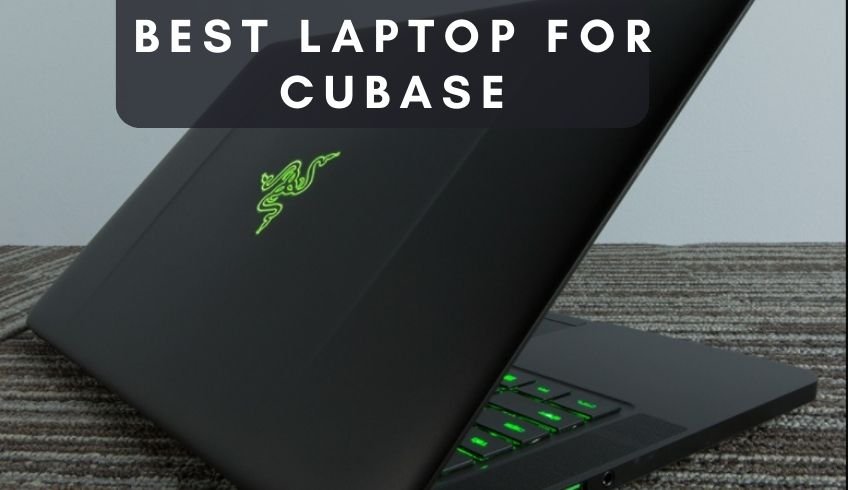Cubase is a music production app. As light and clear as this sounds, it actually is a lot more. This flagship product by Steinberg – a reputable name for audio and hardware solutions – is as efficient as it is hyped for.
However, great things come with a price. To function effectively, Steinberg Cubase requires you to have a device with certain specifications that enable the application to perform at its maximum capacity.
This perhaps forms the primary reason for this article where we aid users like you to find the best laptops for Cubase.
Having established a staunch foreground of the importance of Cubase, it’d rather cause obliviousness if I would neglect and not emphasize the fact that Cubase is a companion for musicians.
Although technically, it is a competitor of the old-school instrument players (no offense), it is quite popular with digital audio workers.
Before diving straight into our core topic here, I would like to take a moment first to establish what Cubase is and what the prerequisites are for this software to operate smoothly, without any interruptions and limitations.
What is Cubase?
In technical terminologies, Cubase is a Digital Audio Workstation (DAW). This software enables you to undertake nearly any task related to music and audio in a layman’s language.
Whether it is the initial stage of recording, or the later and rather complex processes of mixing, editing, composing, and synthesizing. They are all combined into this single software that is now taken up a notch with the latest Cubase 11 and Pro versions.
Breaking it categorically, this software possesses every feature needed to efficiently compose, record, sequence, edit, and mix audio.
Not just that, to enhance the degree of digitality, it consists of virtual instruments, presets, and MIDI effects. This means that the software is an all-rounder.
Although it gives you the option to accept input from external devices, you really don’t need them when you have it all within Cubase.
The reason why Cubase and, simultaneously, Steinberg caught such eminence is due to the highlighted and exceptional features incorporated within this workstation that allow complete autonomy, superior abilities, and outright functionalities for users.
Among the many remarkable traits of Cubase, the below listed are the most prominent ones and are highly admired.
Channel Strip:
The professional mixing tool allows users to closely and extensively mix their sounds by assigning modules to specific channels.
Having access to Cubase Pro further opens the doors for advanced Channel Strip, enabling you to work with the entire palette, thereby crafting even better and even professional pounds.
Chord Pads:
Chords are undeniably at the heart of every piece of music. Realizing this, Cubase has assigned specific attention to it and enables prominence to it by way of the Chord Pads.
To state succinctly, this feature allows you to quickly and easily work with composing. The most impressive ability of these pads is the fact that they will never let you lead away.
You’ll have continuous inspirations at hand while composing, so your music is at its best.
Audio Warp Quantize:
This feature makes it a lot easier to quantize single audio or audio loops with a mere mouse click.
This otherwise difficult and rather time-consuming task of non-destructively warping the audio is also unalterably maintained to follow the tempo and pitch changes.
Retaining such qualities and high-functioning features, it is evident that it will require a PC that adequately satisfies such a viable software’s demands.
Below, I go on to describe the necessary specs that the best laptop for Cubase shall possess.
What Hardware is Needed for Cubase?
Broadly speaking, an average off-the-shelf laptop consists of specifications that are not compatible with Cubase or most of the pro-level audio production software, say Nuendo (from the same production house Steinberg).
Sure, you can download it and even begin working with it, but the eventual glitches and hiccups you will encounter will force you to scratch your head!
To prevent this from happening, it is beyond doubt that you will have to look for some key factors when you shop for the best computer for audio production.
CPU:
The Central Processing Unit (CPU) is the brain of a computer. Just as the human brain functions, the CPU similarly executes instructions to the computer program.
This is of particular significance as it determines how effectively and smoothly the operation will take place.
Generally, there is a combination of Cores and Clock Speed that you need to consider when selecting the CPU. The Core is the number of virtual CPUs, whereas the Clock Speed is how fast do those Cores function.
A universal rule of thumb is that you should purchase a laptop with the maximum CPU within your budget. Ideally, this would be a Core i5 or above.
This is particularly a critical factor to pay attention to as usually, a basic and budget-friendly laptop would cut down on the CPU, and you really don’t want that for your audio production needs.
As far as the reason for this is concerned, of course, cost-cutting is one of them, but apart from that, it is well-known that a slow CPU also means extended battery life. Typically, a slower CPU works just fine if it is everyday work you are talking about.
In fact, it’s better if you get longer battery life. However, when it comes to audio production, this isn’t the case. Cubase is not a joke and unquestionably not the software any PC could handle.
RAM:
Random Access Memory (RAM) is yet another crucial feature that determines your Cubase functioning’s efficacy.
To put it concisely, it is a form of storage within your computer that accesses data randomly from your hard drive and transmits it to your CPU.
Again, it is a vital feature to look for in your device as a bare minimum RAM device can cause several issues when it comes to virtual instruments, plugins, and other high-consumption features.
Hence, a laptop will smoothly function Cubase if it consists of RAM that is at least 8 GB. The more it is, the better it gets.
Storage:
It is pretty evident that the music created from such fine software will have excellence in every bit. Better quality sound means greater storage requirements.
This is where the hard drive comes in. It is a well-known fact that hard drives are expensive, especially the ones that are fast and big.
Hence, it is crucial that when you go for a laptop for Cubase, you preferably give sufficient consideration to the storage it has to offer. Ideally, an SSD storage and a device with multiple drive options are better.
Display:
Cubase is known for its extensive and advanced options. The wide array of different facilities it has to provide users is perhaps the major reason for its popularity and widespread use.
And obviously, the fact that it possesses finesse in each one of them. Be it the simplicity of the options or the minimalist effort needed in producing high-quality sound, Cubase is truly an excelling app.
While this is true, it is also true that this requires, along with many other technical specs (discussed above), a high-resolution widescreen.
As surprising as it may be to some users, a fact to reckon here is that a good quality picture is essential for audio production software as well. This is for you to have an uninterrupted view of the options and also because Cubase has a high dpi.
Keeping these and other aspects in mind, it sure isn’t an easy task to find the best laptop for Cubase. It requires extensive research, comparison, and most importantly, dedicated time to find one that matches all your preference.
How about I say that all that’s out of the way as I have done that for you? All you need to do is read through the article till the end to find all the best options you have available and then accordingly decide which one’s your suited option.
Without further dragging it, let’s get straight onto the list of Best laptops for Cubase in 2021.
List of Best Laptops for Cubase (7/8/10/11)
#1. Acer Swift 3 – Best Laptop for Cubase 11
Up until now, considering the demanding behavior of Cubase, it practically seemed impossible to expect to get a device that efficiently runs the software within an acceptable price range.
To adequately drive out the cliche, Acer Swift 3 came around.
This uniquely configured device puts others to shame when it provides some of the most pricy features packed into a commendable aluminum chassis and a price tag that’s ever since been unbelievable.
Acer Swift 3 comes with an elegantly designed body that’s not only mesmerizing to look at but equally ravishing to touch.
With a weight as light as 2.65 pounds and a thickness that barely extends up to 0.63 inches, the device is a perfect combination of slimness, sleekness, and stylishness.
This makes it evident that you will not face any hurdles when it comes to working on the move. If we talk about what matters the most for audio production, the processing speed and other performance benchmarks are met sufficiently.
Thanks to the AMD Ryzen 7 4700U Octa-Core Mobile Processor, you don’t need to worry about this device’s swiftness and efficiency.
Moreover, it has an overwhelming SSD storage that goes up to 512 GB and a Windows 10 Operating System.
Although compromising on the RAM that is at the bare minimum operational capacity of 8 GB, the rest of the features, considering the price offered, are truly the best deal.
Of course, the same price (which I have most assertively mentioned several times) has also inflicted some limitations, which are visible in the form of the display and sound quality.
Not that they both are at their worst, but surely not at their best either. The display consists of a decent 14-inch screen with 1920 x 1080 pixels and LED backlighting.
Providing a 16:9 screen-to-body ratio, Acer Color Intelligence, and ExaColor, I sure wouldn’t render the screen incapable of displaying Cubase’s features adequately.
Overall, it’s a great deal, especially if you are tight with the budget and are ready to work with the most necessity and fulfilling laptop with few perks and added benefits.
#2. ASUS ROG Strix GL702VS (Best Laptop for Cubase 10)
This one is ideally designed for gamers. The Asus ROG Strix has meticulously been designed to suit the beastly performance needs and outstanding display requirements of gamers.
Wait a minute, isn’t that also suitable for Cubase? That’s right! The performance customizations adequately meet the demands of Cubase, thereby making Asus ROG Strix GL702VS a perfect match for it.
The device consists of the NVIDIA GeForce GTX 1070 8GB Graphics Card that smoothes out the rendering of graphical stuff and frees up the Intel Core i7 Processor for other essential tasks.
This, along with the 12GB RAM, 128 GB SSD, and 1 TB 7200RPM HDD, ensures fast and glitch-free performance with mighty storage space.
In what way is this not ideal for Cubase? As if this wasn’t enough, the ROG Strix then incorporated a wide view panel 17.3-inch display with a Full HD 1920×1080 resolution.
This not only gives a better view of all of Cubase’s mesmerizing options but, due to the bigger screen size, enables you to have it all in front of you. Bigger screen size does not necessarily mean that it is bulkier.
In fact, it weighs as low as 6.4 lbs and is as thin as 0.94 inches. This means that it is an accurate partner for you to travel with.
And how can we miss out on the duo-copper thermal technology with dual cooling fans that allow you to work uninterruptedly with heavy software like Cubase?
#3. Apple MacBook Pro
This belief comes down from generations, and there is no harm in placing reliance on it; Apple devices are great to work with for creative arts.
Having said that, it becomes evident that since audio production is a form of creative arts, Apple sure has some great things to offer! Arguably, the music industry seems to be fairly dependent upon the Mac device.
Perhaps the greatest reason that is mainstream regarding the MacBook Pro is its performance. What better word than savage to describe just how beastly it performs?
Thanks to the Intel Core i9 processor embedded into the device, which consists of up to 8 cores and 16 threads of power. More power means better performance. And this is evident once it comes to using resource-consuming software like Cubase.
To further contribute to this device’s superiority, there is the mightiness of up to 8 TB SSD storage and up to 128 GB memory.
And how can we miss out on the Retina display of Apple? The Apple MacBook Pro is incorporated with a stunning 16-inch Retina display with P3 wide color gamut.
Concisely put, it delivers brilliant pictures and, needless to say, supports the high dpi of Cubase.
However, a general misconception lies here whereby people think that the only way to get around with any sort of creative fieldwork is to buy the insanely expensive Apple device.
It is true and indeed the biggest drawback attached to the Apple MacBook Pro; is its price.
#4. Acer Predator Helios 300
The Predator Helios 300 is truly an Acer due to its commendable performance and display features. Although peculiarly designed for gamers, the blistering capabilities of this device are equally ravishing and fulfilling for Cubase.
The device is power-packed with the 10th Gen Intel Core i7 processor, up to 32 GB of outstanding DDR4 RAM, and expandable up to 2 TB of mesmerizing SSD.
And how can we miss out on the NVIDIA GeForce RTX 3080 GPU coupled with the 4th Gen AeroBlade 3D Technology? Together, these features make this device a literal predator!
So, as far as performance is concerned, Cubase is sure to adore these specifications and be more than willing to work on this device uninterruptedly.
To further enhance its adequacy, the Predator Helios 300 comprises a 15.6-inch Full HD IPS display with a 1920 x 1080 widescreen resolution. Along with this, it is powered by Acer TrueHarmony technology which ensures the sound is perfectly streamlined too!
A great display with an even better sound, what more do you need? Of course, it’s a device by Acer; it has to excel at things! Mainly focused on gaming, there are some customizations that a music industry professional wouldn’t otherwise have. One such feature is the red backlit keyboard.
As mundane as it may sound, equally exciting it is for gamers. So we could rationalize here and let this slip out considering the other exceptional specifications that the Acer Predator Helios 300 provides you with.
#5. Lenovo ThinkPad E595
The only two words I can come up with when talking about the Lenovo ThinkPad E595 are stylish and affordable.
Of course, this does not rule out the fact that it is efficient and reliable when considering it as an option for Cubase. In fact, that’s the major reason it made it to the list. This device is the right combination for what we call business users.
Coming with a compelling facade, smooth lines, and metallic finish, looks are indeed a priority with the ThinkPad. As stylish as it is, equally sturdy is its construct, thanks to the ironclad durability it possesses.
All of this is compiled into a laptop that weighs just 3 lbs. Now that’s fascinating! Talking business now, since performance is our main concern here, the Lenovo ThinkPad excels at that too!
With an up to AMD Ryzen 7 3700U processor and 32GB RAM, complex and resource-consuming music production on Cubase is not a problem at all.
Plus, there is the default 512 GB SSD storage that’s upgradeable to a good size of 2TB so that you can store high-quality sounds and mesmerizing audio on it.
Having firmly established the ThinkPad’s excellent performance capabilities, let’s not miss the exceptional other features that it possesses.
The 15.6-inch FHD display comes with great anti-glare technology, which ensures minimal eye strain for longer work hours. Moreover, the dual-array mics and stereo speakers with Dolby Audio ensure that sound quality is to its maximum too.
#6. ASUS VivoBook – Best Laptop for Cubase 7
It is indeed a very worthy addition to this list as it makes a perfect match for Cubase. Although underrated, the VivoBook is undeniably one of the best picks for an under-the-budget music production device.
I could safely call this stylish yet thin and light laptop a choice for those who relish portability. With a weight that only extends up to 3 lbs and thickness that merely goes to 0.78 inches, what better word to compliment it than feathery?
To state conclusively, VivoBook is a powerful laptop that can be used efficiently to carry out high-end music production on Cubase.
Coming with an Intel Core i7-7700HQ Processor to boost the speed, 16GB DDR4 RAM for smooth functioning and a 256GB SSD+1TB HDD for ample storage, no tables are left unturned when it comes to efficacy. And not to miss the added benefit of the GeForce GTX 1050 4 GB graphics.
What’s more? You get a 15.6-inch Full HD screen with a color-rich and anti-glare display allowing you to work for longer—a truly lifelike visual experience.
The Asus VivoBook also boasts an immersive sound system, and to top it all off is the intelligent cooling system which lets your laptop take any workload with minimal heating. The cohesion of these features makes it a device that’s ever since light as it is powerful.
#7. Microsoft Surface Laptop 2
Last but not least on this list of Best laptops for Cubase in 2021 is the Microsoft Surface laptop 2. This device, created by the leading Microsoft, is over the edge when it comes to functionality, stylishness, and of course, portability.
The premium build quality and design composition of the Surface Laptop 2 is an exuberant feature that’s worth the mention.
Coming in a classy chassis and an extremely lightweight body, it is a perfect fit for those on the go.
Coming to the laptop’s impeccable performance features, we could begin listing them by first starting with the processor that starts with the 8th Gen Intel Core i5 and goes up to i7 – more than enough to fulfill the requirements of Cubase.
Furthermore, complementing this processing power is the SSD which ranges from 128GB to 1TB, and the RAM, which goes up to 16 GB.
A perfect combination of all the features! In addition to this, the device holds a clear edge in terms of the outstanding display quality it provides.
Coming with a 13.5-inch vibrant screen consisting of PixelSense technology and razor-sharp resolution with the bonus of a touch screen, it truly is a stunning view!
Along with that, you also get an omnidirectional sound system and, obviously, the perks of owning a Microsoft device! These are vehement indicators of the excellence of the Microsoft Surface laptop 2.
Conclusion
It’s simple; mediocrity cannot suffice Cubase. It needs something extra to ensure smooth functioning. The reason for this is the fact that Cubase isn’t just any other music production software.
It consists of a load of features that are based on precision and are high-functioning. It allows the creation of music that is a treat to the ears with great sound quality and the software’s intelligent suggestions.
Such immaculate options surely don’t come without a price. And the price you need to pay is quite evident – a laptop that fulfills all the requirements of Cubase. These requirements are mainly in terms of capacity, processing power, and speed.
All the laptops listed above are thereby proven to function with this software without any hiccups effectively.
Whether it is a high-end brand such as the Apple MacBook or Microsoft Surface that you go for, or more affordable options like those provided by Acer and Asus, common grounds between all of them is Cubase and the security of them proving to be the best laptops for Cubase!







